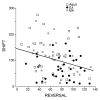The impact of social stress during adolescence or adulthood and coping strategy on cognitive function of female rats
- PMID: 25746514
- PMCID: PMC4390539
- DOI: 10.1016/j.bbr.2015.02.047
The impact of social stress during adolescence or adulthood and coping strategy on cognitive function of female rats
Abstract
The age of stressor exposure can determine its neurobehavioral impact. For example, exposure of adolescent male rats to resident-intruder stress impairs cognitive flexibility in adulthood. The current study examined the impact of this stressor in female rats. Rats were exposed to resident-intruder stress during early adolescence (EA), mid-adolescence (MA) or adulthood (Adult). They were tested in an operant strategy-shifting task for side discrimination (SD), reversal learning (REV) and strategy set-shifting (SHIFT) the following week. Performance varied with age, stress and coping style. MA and EA rats performed SD and SHIFT better than other ages, respectively. Social stress impaired performance in rats depending on their coping strategy as determined by a short (SL) or long (LL) latency to become subordinate. SL rats were impaired in SD and REV, whereas EA-LL rats were impaired in SHIFT. These impairing effects of female adolescent stress did not endure into adulthood. Strategy set-shifting performance for female adolescents was positively correlated with medial prefrontal cortex (mPFC) activation as indicated by c-fos expression suggesting that this region is engaged during task performance. This contrasts with the inverse relationship between these indices reported for male adolescent rats. Together, the results demonstrate that social stress produces cognitive impairments for female rats that depend on age and coping style but unlike males, the impairing effects of female adolescent social stress are immediate and do not endure into adulthood. Sex differences in the impact of adolescent social stress on cognition may reflect differences in mPFC engagement during the task.
Keywords: Development; Prefrontal cortex; Resident-intruder; Reversal learning; Sex difference; Strategy shifting.
Copyright © 2015 Elsevier B.V. All rights reserved.
Figures





Similar articles
-
Corticotropin-releasing Factor in the Rat Dorsal Raphe Nucleus Promotes Different Forms of Behavioral Flexibility Depending on Social Stress History.Neuropsychopharmacology. 2015 Oct;40(11):2517-25. doi: 10.1038/npp.2015.98. Epub 2015 Apr 13. Neuropsychopharmacology. 2015. PMID: 25865931 Free PMC article.
-
Cognitive impact of social stress and coping strategy throughout development.Psychopharmacology (Berl). 2015 Jan;232(1):185-95. doi: 10.1007/s00213-014-3654-7. Epub 2014 Jun 24. Psychopharmacology (Berl). 2015. PMID: 24958230 Free PMC article.
-
Acute stress impairs set-shifting but not reversal learning.Behav Brain Res. 2013 Sep 1;252:222-9. doi: 10.1016/j.bbr.2013.06.007. Epub 2013 Jun 10. Behav Brain Res. 2013. PMID: 23764458
-
Impact of juvenile chronic stress on adult cortico-accumbal function: Implications for cognition and addiction.Prog Neuropsychopharmacol Biol Psychiatry. 2017 Oct 3;79(Pt B):136-154. doi: 10.1016/j.pnpbp.2017.06.015. Epub 2017 Jun 19. Prog Neuropsychopharmacol Biol Psychiatry. 2017. PMID: 28642080 Free PMC article. Review.
-
Effects of stress on behavioral flexibility in rodents.Neuroscience. 2017 Mar 14;345:176-192. doi: 10.1016/j.neuroscience.2016.04.007. Epub 2016 Apr 9. Neuroscience. 2017. PMID: 27066767 Review.
Cited by
-
Synaptic Plasticity, Metaplasticity and Depression.Curr Neuropharmacol. 2017;15(1):71-86. doi: 10.2174/1570159x14666160202121111. Curr Neuropharmacol. 2017. PMID: 26830964 Free PMC article. Review.
-
Age- and Sex-Dependent Impact of Repeated Social Stress on Intrinsic and Synaptic Excitability of the Rat Prefrontal Cortex.Cereb Cortex. 2017 Jan 1;27(1):244-253. doi: 10.1093/cercor/bhw388. Cereb Cortex. 2017. PMID: 28013234 Free PMC article.
-
Coping in Mid- to Late Life and Risk of Mild Cognitive Impairment Subtypes and Dementia: A JPHC Saku Mental Health Study.J Alzheimers Dis. 2022;90(3):1085-1101. doi: 10.3233/JAD-215712. J Alzheimers Dis. 2022. PMID: 36213991 Free PMC article.
-
Chronic stress produces enduring sex- and region-specific alterations in novel stress-induced c-Fos expression.Neurobiol Stress. 2019 Feb 1;10:100147. doi: 10.1016/j.ynstr.2019.100147. eCollection 2019 Feb. Neurobiol Stress. 2019. PMID: 30937353 Free PMC article.
-
The Role of PDE11A4 in Social Isolation-Induced Changes in Intracellular Signaling and Neuroinflammation.Front Pharmacol. 2021 Nov 23;12:749628. doi: 10.3389/fphar.2021.749628. eCollection 2021. Front Pharmacol. 2021. PMID: 34887755 Free PMC article.
References
-
- Marin MF, Lord C, Andrews J, Juster RP, Sindi S, Arsenault-Lapierre G, et al. Chronic stress, cognitive functioning and mental health. Neurobiol Learn Mem. 2011 - PubMed
-
- Kessler RC. The effects of stressful life events on depression. Annual review of psychology. 1997;48:191–214. - PubMed
-
- Carr CP, Martins CM, Stingel AM, Lemgruber VB, Juruena MF. The role of early life stress in adult psychiatric disorders: a systematic review according to childhood trauma subtypes. J Nerv Ment Dis. 2013;201:1007–20. - PubMed
Publication types
MeSH terms
Substances
Grants and funding
LinkOut - more resources
Full Text Sources
Other Literature Sources
Medical

